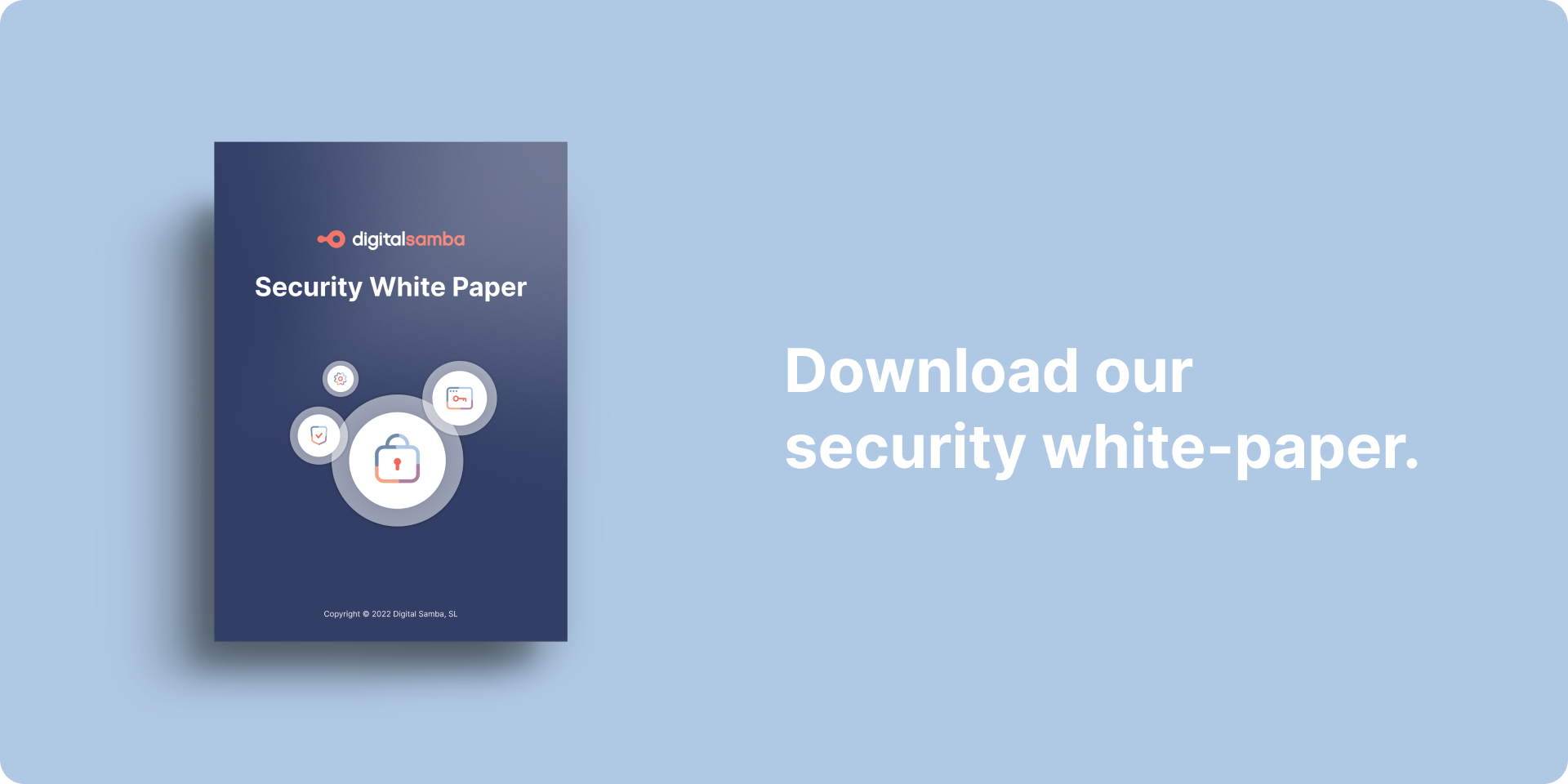Benefits of using WebRTC for Online Education and eLearning
WebRTC (Web Real-Time Communication) is a ground-breaking technology reshaping online education. With real-time communication capabilities in web browsers, it enables seamless video calls, audio chats, and interactive experiences without extra downloads or plugins.
WebRTC simplifies setups, transcends boundaries, and offers flexible learning solutions. It enhances engagement, fosters collaboration, and provides an immersive learning experience.
Table of Contents
- What is WebRTC?
- What are the technical requirements for using WebRTC?
- What are the advantages of using WebRTC for online education and eLearning?
- Real-time communication
- Accessibility and flexibility
- Security and privacy
- Scalability and cost-effectiveness
- WebRTC use cases in online education and elearning
- Future of WebRTC
- Improve your users’ eLearning Experience with Digital Samba's WebRTC API-integrated video chat
In this article we’ll explore WebRTC's transformative potential, uncovering its advantages in revolutionising the virtual learning landscape.
What is WebRTC?
As explained in a previous article, WebRTC is an open-source HTML 5 specification that provides standardised protocols and APIs to enable real-time communication between devices on the web. It empowers developers to create video conferencing platforms by providing easy-to-integrate APIs.
What are the technical requirements for using WebRTC?
To utilise WebRTC, you need to have a compatible web browser that natively supports WebRTC. However, this is not an issue since most of the major browsers such as Chrome, Firefox, Safari and Opera, already have built-in WebRTC support. This ensures compatibility and consistency in user experience.
WebRTC also operates on most devices equipped with audio and video capabilities, operating systems, and on different network conditions providing reliable real-time communication capabilities.
Due to its diverse capabilities, WebRTC is implemented across all sectors that use video or audio calls for communication. One of those sectors is the education sector, where WebRTC is implemented in eLearning and online learning.
What are the advantages of using WebRTC for online education and elearning?
Real-time communication
One of the most crucial factors to consider when hosting a virtual classroom or lecture is real-time communication. Through WebRTC’s capabilities, educators and learners can engage in seamless and interactive communication, fostering a dynamic virtual learning environment.
-
Video and audio quality
WebRTC ensures high-quality video streaming, enabling participants to experience smooth and visually impactful content. The technology allows for excellent resolution, ensuring clear visuals and effective interpretation. Additionally, WebRTC provides crystal-clear audio transmission, guaranteeing that discussions and lectures are audible and engaging.
WebRTC ensures this through a combination of factors such as modern audio and video codecs, such as Opus and VP8, adaptive bitrate control to adjust the video and audio quality based on the available network bandwidth, and network traversal techniques like Interactive Connectivity Establishment (ICE) and Session Traversal Utilities for NAT (STUN).
-
Interactive teaching and learning
WebRTC facilitates real-time video conferencing, empowering educators to conduct interactive virtual classrooms. This enables active participation from students, creating a collaborative and engaging learning environment.
With WebRTC, educators can share their screens, demonstrate concepts, present materials, and promote visual learning. The technology also supports interactive whiteboarding, allowing real-time collaboration, brainstorming, and annotations, fostering creativity and active engagement.

-
Collaborative learning
Just like a physical classroom, virtual classrooms leverage WebRTC to provide students with the opportunity to collaborate in group projects, and discussions as well as knowledge sharing promoting teamwork and cooperation.
Additionally, WebRTC supports virtual office hours, allowing educators to provide personalised guidance, clarifications, and one-on-one support to students, regardless of their physical location.
Accessibility and flexibility
WebRTC offers significant advantages in terms of accessibility and flexibility, making it an ideal solution for online education, especially when combined with accessibility checkers to ensure a universally inclusive experience. Its capabilities enable educators and learners to enjoy seamless learning experiences that transcend physical boundaries and adapt to various devices and network conditions.
-
Anytime and anywhere learning
WebRTC allows for flexible scheduling, enabling educators to deliver live classes and interactive sessions at times that accommodate learners in different time zones. Additionally, recorded WebRTC sessions provide on-demand access to educational content, allowing for self-paced learning.
Moreover, WebRTC facilitates remote learning opportunities, reaching learners who may not have access to traditional educational settings due to distance or other constraints.
-
Mobile-friendly
WebRTC is compatible with a wide range of devices, including smartphones and tablets, making it highly mobile-friendly. Learners have the flexibility to access educational content on their preferred devices.
The technology's responsive design ensures optimal user experience, adapting to different screen sizes and resolutions on mobile devices.
-
Low bandwidth requirements
WebRTC is designed to optimise bandwidth usage, ensuring efficient transmission of audio and video even in low-bandwidth environments. It minimises data consumption, making it cost-effective for learners with limited internet connectivity or data plans.
Security and privacy
WebRTC prioritises the security and privacy of online education, offering robust features such as E2EE and GDPR compliance that safeguard sensitive data and protect communication channels. These features ensure a secure and trustworthy learning environment for both educators and learners.

The Digital Samba Security White Paper
Download now
-
End-to-end encryption
Among its many components, WebRTC also incorporates end-to-end encryption, a critical security measure that protects the confidentiality of data transmitted during eLearning sessions. With end-to-end encryption, data is secured by being encrypted on the sender’s device and only decrypted on the intended recipient’s device. This eliminates the risk of unauthorised access or interception.
This ensures that sensitive information, such as students’ personal details, assignments, and assessments, remains secure and confidential.
-
Secure Data Transmission
WebRTC utilises secure transport protocols, such as Datagram Transport Layer Security (DTLS) and Secure Real-time Transport Protocol (SRTP), to ensure secure data transmission over the network.
These protocols provide authentication, encryption, and integrity checks, preventing unauthorised access, tampering, and eavesdropping. By employing these robust security measures, WebRTC guarantees the integrity and confidentiality of educational content and communication.
-
No downloads or plugins are required
One of the inherent advantages of WebRTC is its browser-based functionality, eliminating the need for additional downloads or plugins. This streamlined approach enhances security by reducing the risk of malicious software or vulnerable plugins compromising the online education environment.
With WebRTC, educators and learners can connect directly through their web browsers, ensuring a secure and hassle-free experience without the need for external software installations.

Scalability and cost-effectiveness
WebRTC also offers remarkable advantages in terms of scalability and cost-effectiveness, making it an ideal solution for eLearning platforms of all sizes. Its inherent features not only make it scalable enough to handle a large number of users but also a cost-effective solution for educational institutions.
-
Scalability
WebRTC's peer-to-peer connectivity and multiparty communication capabilities allow for direct communication between a large number of users. This eliminates the need for centralised servers that are required to handle every interaction.
WebRTC’s decentralised architecture enables developers to create scalable online education platforms that can handle a high volume of concurrent users without compromising performance.
-
Cost-effectiveness
WebRTC utilises existing web browsers and devices, eliminating the need for additional infrastructure investment. As such, educational institutions can leverage the technology without significant hardware or software upgrades, reducing costs associated with implementation and maintenance.
WebRTC also reduces operational costs through its sufficient bandwidth utilisation and decentralised architecture which minimises bandwidth requirements. Consequently, making online education more affordable for institutions and accessible to students with limited resources.
Lastly, WebRTC also eliminates the reliance on third-party services for real-time communication. Educational platforms can leverage WebRTC's built-in capabilities, reducing costs associated with licensing or subscribing to external communication solutions.
WebRTC use cases in online education and elearning
WebRTC technology offers a multitude of practical applications in the realm of online education and eLearning. Let's explore some specific WebRTC implementations where WebRTC enhances the learning experience and enables effective educational practices.
-
Virtual classrooms and lectures
WebRTC facilitates the creation of virtual classrooms and delivers engaging lectures in real time. Educators can utilise video and audio streaming, interactive whiteboards, and chat functionality to conduct immersive virtual learning environments. Students can actively participate, ask questions, and collaborate with peers, fostering a dynamic and interactive educational experience.

-
One-on-one tutoring
WebRTC also allows educators to provide personalised one-to-one sessions. Through video calls, screen sharing, whiteboards and other collaborative tools, educators can offer personalised guidance and interactive learning experiences to students. This personalised approach improves student understanding, addresses specific learning needs, and promotes academic growth.
-
Collaborative learning activities
By connecting learners from various locations, WebRTC also enables collaborative learning activities. Students can engage in group projects, discussions, and problem-solving activities through video conferencing, document sharing, and interactive tools. This technology promotes teamwork, encourages peer-to-peer learning, and cultivates a sense of community among learners.
-
Remote assessments and evaluations
WebRTC supports assessments and evaluations in online education. Educators can utilise video-based proctoring to monitor students during exams and assessments, ensuring academic integrity.
Additionally, WebRTC enables interactive assessments, such as oral exams or video-based discussions, to evaluate students' comprehension and critical thinking skills effectively.
These are just a few examples that highlight the versatility of WebRTC in online education and eLearning.
Future of WebRTC
The future of WebRTC holds promising advancements in RTC connecting, revolutionising real-time communication over the Internet. As technology progresses, we can anticipate significant developments that will enhance how devices establish connections and interact.
Ongoing research and innovation in WebRTC will focus on improving network traversal techniques, bolstering security measures, and optimising performance. These efforts aim to ensure reliable and efficient connections between devices, irrespective of their network configurations.
Looking ahead, the future of WebRTC envisions the integration of emerging technologies such as AI, augmented reality, and the Internet of Things (IoT). This convergence will unlock new dimensions for RTC connecting, enabling richer interactions, immersive collaborations, and seamless connectivity across diverse devices and platforms such as eLearning and online education.

Improve your users’ e-learning experience with Digital Samba's WebRTC API-integrated video chat
Our eLearning API offers a reliable and secure WebRTC-based virtual classroom solution. With our eLearning API, educators on your platform can easily set up virtual classrooms and conduct interactive sessions with students globally.
By leveraging WebRTC, our eLearning API offers a secure, cost-effective and scalable solution for your online education sessions. What’s more, your users also benefit from the flexibility and accessibility of WebRTC-based platforms, allowing them to learn and collaborate with others at their own pace and convenience.
Get started with Digital Samba’s API for elearning today! Sign up with a free account today to experience the benefits of Digital Samba firsthand with 10,000 free participation minutes per month.
Share this
You May Also Like
These Related Stories

Best Webinar Platforms for Online Education in 2025

Encryption Solutions for Telehealth Platforms


